THANK YOU SIR MAY I HAVE ANOTHER
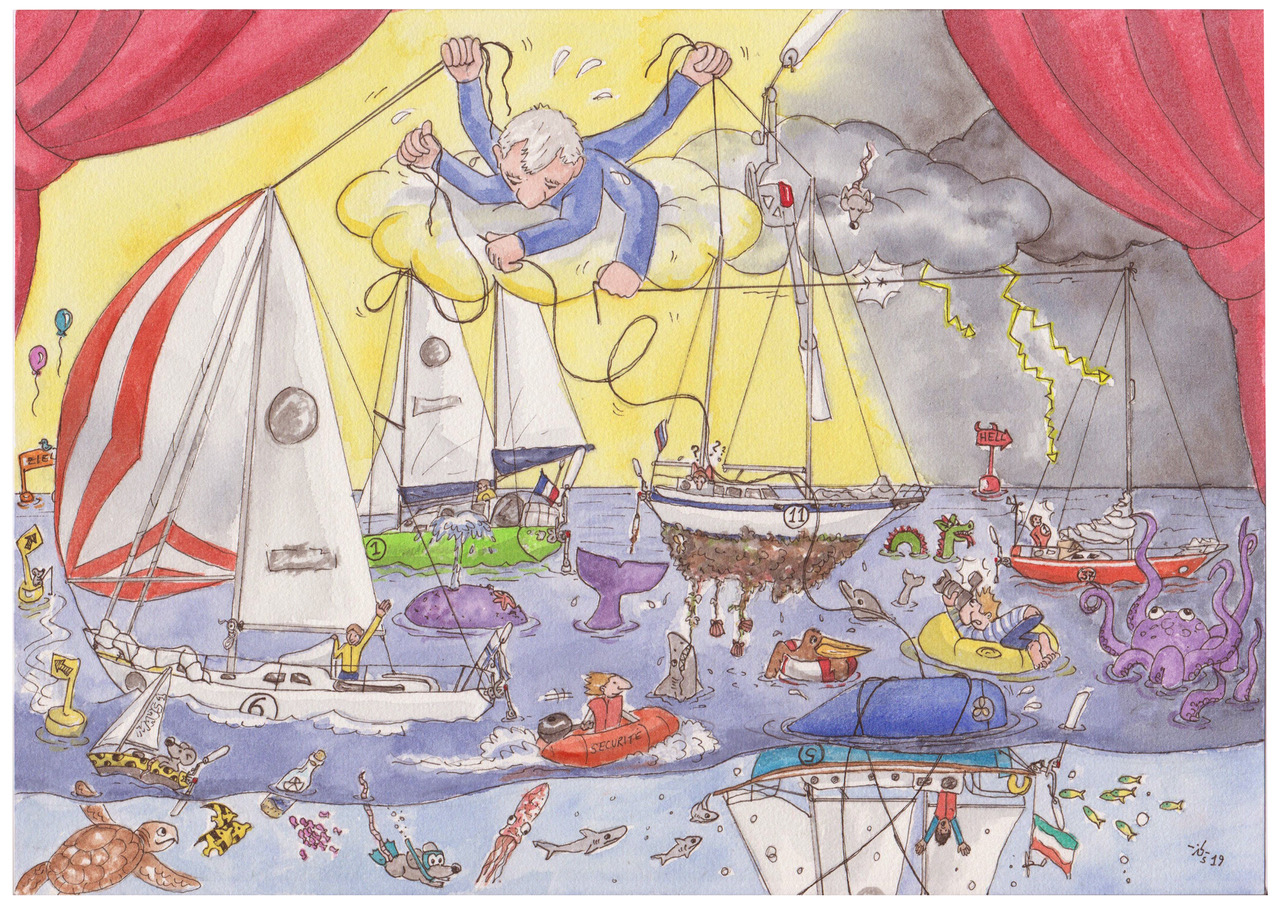
Two months on, change is afoot in the rules. Has the mountain moved? Has the organiser seen the light? Looking at the NOR 2022, I sense a measure of reflection and clear signs of a little tweaking and tidying here and there. Naturally it is the edicts on transom ornamentation that concern me most: here at least, I can be reasonably sure of my footing and reasonably confident of not overplaying my hand and falling victim to the circling sharks just waiting for that one careless move. Although the rules run to a stately 63 pages in total, only a few lines – easy to overlook but actually full of significance – have any real relevance for me.
AUTOPILOTS FOR REDUNDANCY
Autopilots remain prohibited just as they were last time; on this the NOR’s Banned Equipment section is explicit. That said, however, the Safety Plan section still reads:
Emergency Cockpit Electric Autopilots may be carried on board an Entrants boat, only if all its components are secured in an approved container and sealed in an approved manner, such that only by Breaking the security seal can the system be installed. An entrant must submit comprehensive details of the chosen container and method of security sealing it for approval to the organisers. If the seal is broken for any reason whatsoever the Entrant will be moved to the Chichester Class. Only the electrical wiring linking the pilot to the boat’s batteries may be installed with one waterproof power plug on deck. No other installation wiring or components are allowed.
I recently learned, from a perfectly unimpeachable source, that three of the fleet (no names were named) in the last GGR took advantage of this option.
Apparently the organiser continues to believe that windvane self-steering systems can cope reliably with the challenges of circumnavigating in the high latitudes – otherwise he would surely have provided (or have had to provide) a better plan B for his sailors, wouldn’t he? I set out the current position – and the attendant immutable principles – in my Windvane Report.
APPROVED WINDVANES
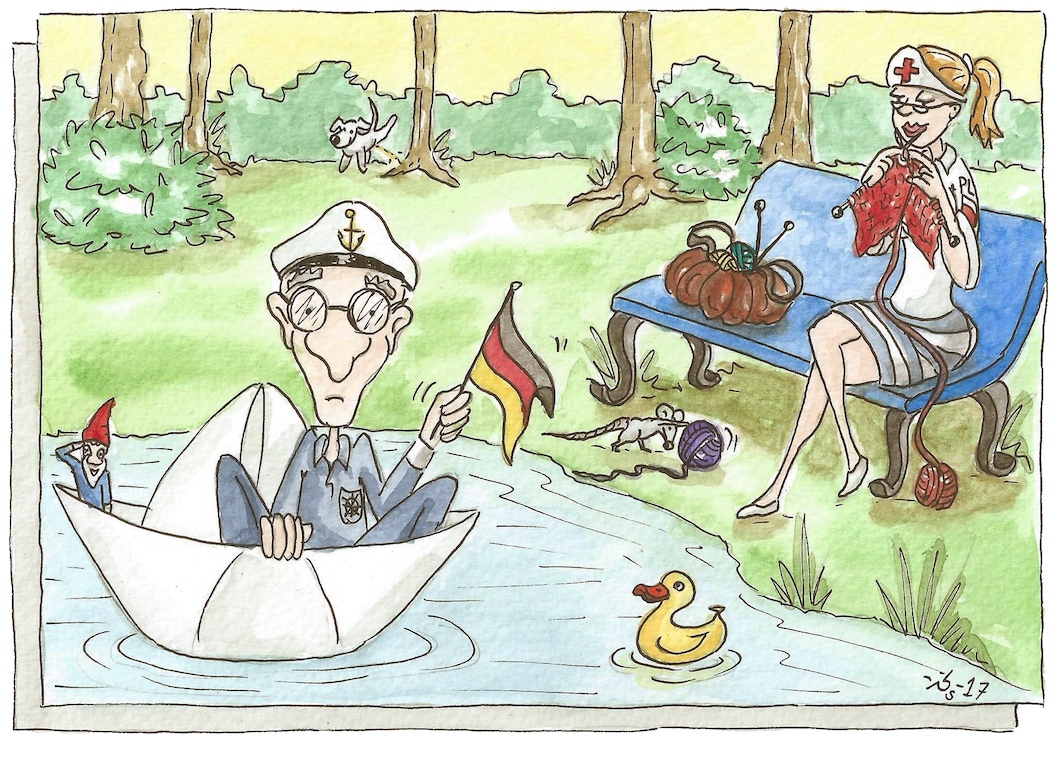
Stating that equipment is “approved” could easily mislead the unwary into thinking it had been rigorously tested and found worthy of endorsement. As explained in the Windvane Report, however, the suitability of our mechanical steering slaves for use in high-latitude racing is strictly limited. Am I astonished that the organiser makes no mention of these limitations alongside his stamp of approval or does it come as no surprise at all?
Wind-vanes currently “approved” for the GGR include Hydrovane, Aries, Windpilot and Monitor-only with GGR Mods. Entrants wishing to use other brands must supply a brief report on why they believe that unit will provide secure service on GGR style boats during storms in the Southern Ocean
Trying to discuss any of this with the organiser, I might add, is a fruitless task because all the traffic is one-way: it has been radio silence throughout despite my having sponsored five competitors in the last race.

Despite being aware of – or at least having no good reason for not being aware of – their weaknesses (overload protection and shear pins), the organiser has given these systems his approval (implicitly affirming that they “provide secure service on GGR style boats”) while at the same time making any use of an autopilot (to my mind a perfectly reasonable back-up option for safety in extremis) punishable by demotion to the Chichester Class. Isn’t there a rather grave conflict of interests at play here? Either way the clear loser is the sailor, who is left having to choose (wholly unnecessarily in this instance) between prudence and ambition in a way that, as we have already witnessed, can put lives in peril.
I wonder if this perhaps actually brings us to the nub of the issue: obviously a race around the world is at least as much a mental challenge as a physical one and the question of how much canvass is too much in a blow never goes away, but having actual rules – rules justified by the organiser with the claim of retro-originality (“authenticity”) – that force competitors to choose between their better judgement and giving up the race is pretty much guaranteed to produce the type of incidents that generate media attention. Yes, it is indeed the athlete’s decision to participate and to continue participating and yes, the athletes know the risks, but in the case of self-steering at least, the risk is greatly magnified by rules that appear to serve little purpose other than creating additional jeopardy for competitors. How ever this situation has come about, it must surely be counterproductive for the event and its stakeholders. I’ll go so far as to call it irresponsible, in fact, because the safety of the sailors involved is knowingly being compromised.
EMERGENCY RUDDERS – A FIG LEAF
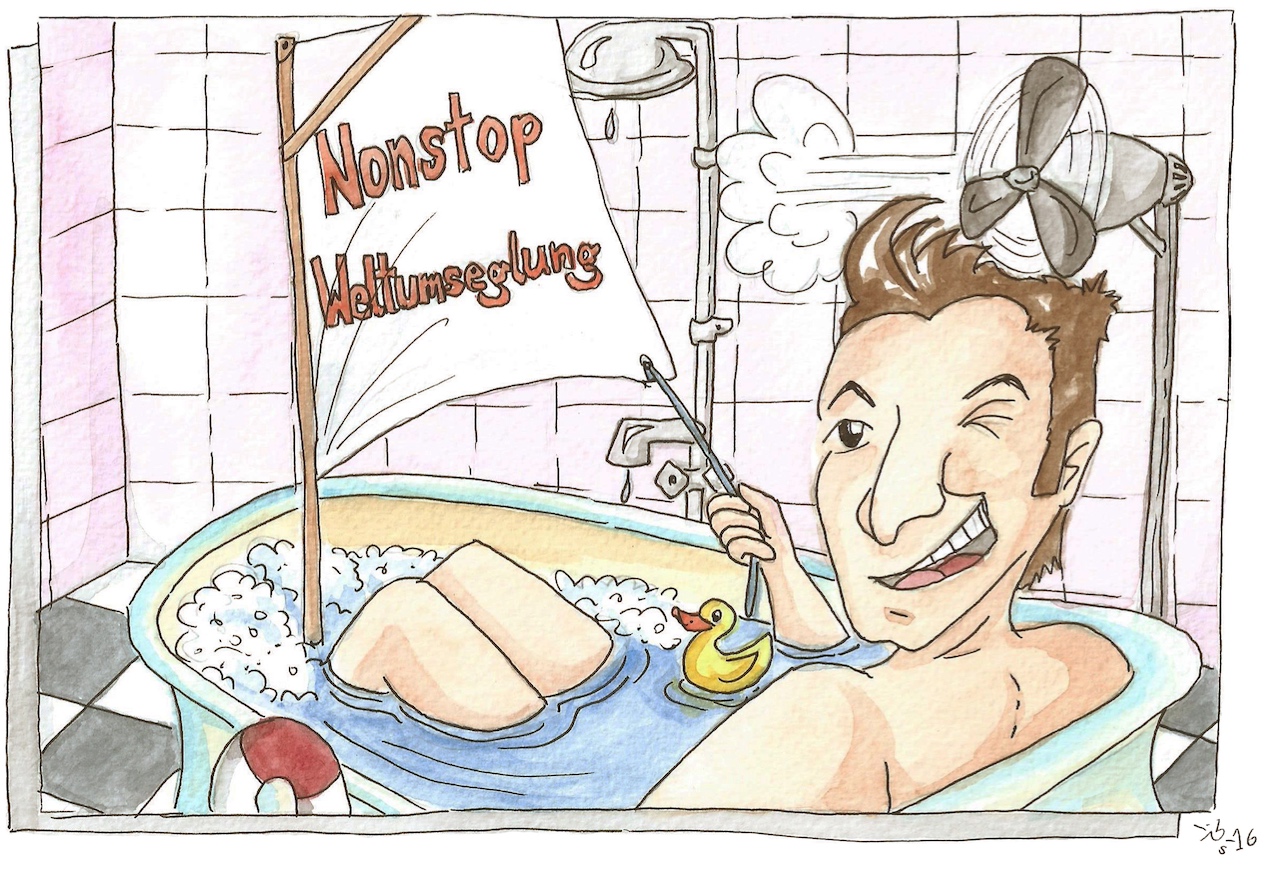
Anyone with the slightest interest in the GGR must by now have grasped that the organiser has a particular preference concerning transom ornaments (a preference that aligns perfectly with the commercial imperatives of his personal sponsor and his apparent hope that the entire fleet might deposit their orders at this sponsor’s door) and it should come as no surprise to hear that the NOR rules repeatedly seek to enforce this preference (albeit in the guise of safety measures): Sponsors no doubt have every right to be treated kindly by the events they facilitate, but this is really something else!
5.1.5 Special equipment regulations
K) If wheel steering is fitted; an effective emergency tiller is required. Supplies and equipment to affect an emergency rudder and steering must be on board. This emergency steering must have been previously installed by one person from the boat and used by the skipper (with the main rudder locked) in the open sea on the entered boat for at least five hours with average wind over 15kts on a triangular course and a full detailed report on its operation and satisfactory performance, with photos, must be submitted with the Race Organiser no later than 30th MAY 2022. A permanent Tiller may replace any standard wheel steering system.
Is it helpful to impose on sailors tempted to go down the “wrong” path in their choice of windvane self-steering system the burden of a practical test to help guide them back onto the organiser’s straight and narrow before they make their final sourcing decisions? Helpful for whom would have to be the question! We are moving onto thin ice, I realise, but I’m prepared to risk a couple of observations on the subject…
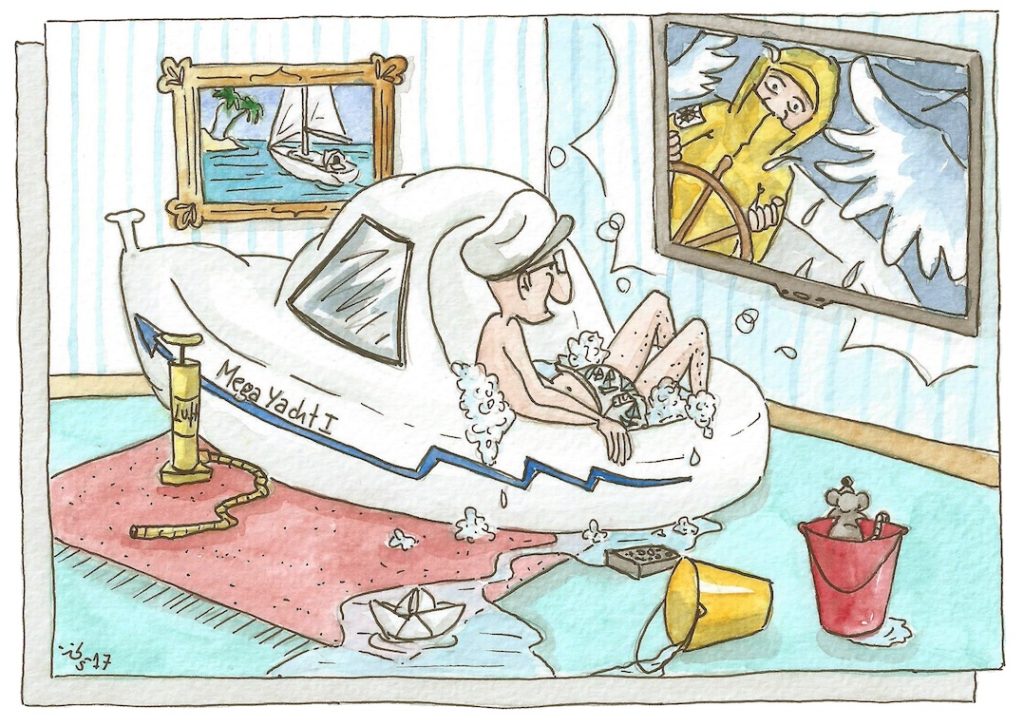
The need for an emergency rudder on boats that have a long keel is open to question; the need for an emergency tiller on boats with wheel steering, on the other hand, is quite beyond doubt. The types of boat used in the GGR would normally be expected to offer the safest ride possible for the rudder and in fact none of the boats suffered rudder system damage in the last race apart from Puffin, which had two inherent problems (planning oversights):
– The wheel steering system was unsuitable for the job in a couple of ways.
– A robust emergency tiller was lacking.
Accepting that boats are required to carry an emergency rudder and to have tested it at sea, the next question (a rhetorical one – I’m not expecting an answer from the organiser) is what anyone is expected to learn from trials conducted (and filmed, no less) “with the main rudder locked”. Doesn’t the fact that it’s emergency rudder time tend to suggest the main rudder has left the building? It would be more realistic to look for evidence of performance with the main rudder not locked, because the lateral surface area of the main rudder is unlikely to be available to assist the emergency rudder in extremis and, having no more than about a third of the effective area of the main rudder, the emergency rudder will find steering much more of a challenge in its absence. The organiser’s conviction that there are benefits to having a windvane self-steering system with an auxiliary rudder also fails to take account of a couple of factors that might ordinarily be considered significant in choosing a self-steering unit:
– The risk of having an unprotected spade rudder right at the stern (flotsam)
– The difficulty of accessing the designated points of failure (shear pins) while sailing.
It may well be, of course, that the organiser’s judgement in this instance is clouded by his existing preferences as discussed above…
I strongly advised Igor, Antoine and Tapio against fitting my Pacific Plus double rudder system for the race precisely because an auxiliary rudder can become a liability on a trip like the GGR. Perched right at the back of the boat and with much of the important hardware close to the waterline, access while at sea is difficult at the best of times and checking and (if necessary) replacing designated points of failure would require the sort of agility generally found in gymnasts rather than sailors. It was for this very reason that Istvan decided – with no input from anyone else – to pass up the Hydrovane option.
Jean-Luc van den Heede, seemingly always a step ahead of the fleet (and of the organiser to boot), optimised his vanegear before the start by uprating the shear pin and shortening the rudder – and took an inflatable dinghy along too to help him reach the business end of the system if necessary. Perhaps the rules should in future require all Hydrovane users to carry a tender just in case? As it happens, even the extra strong shear pin fitted on Matmut broke despite the shortened rudder.
Anyway, there’s nothing to be gained by opening that can of worms again except a reminder that the experience of the last GGR in no way justifies the organiser’s apparently unlimited confidence in the four windvane self-steering systems he has “approved” for the next edition. What happens if a Hydrovane rudder shaft suffers a shear pin break when it is being used in emergency rudder mode? It doesn’t bear thinking about (although it probably does if it could be you). Too far-fetched? Not in my opinion: emergency rudders should not have designated points of failure! If there is going to be a rule about emergency rudders, why not insist on something really tough like the specimens carried by Abhilash and Mark Sinclair? The arguments and rules set out by the organiser really don’t stand up to scrutiny. Forgive me for saying so, but I think this strict emergency rudder requirement adds up to no more than a fig leaf with fringe marketing benefits.
THE GGR IN THE MEDIA
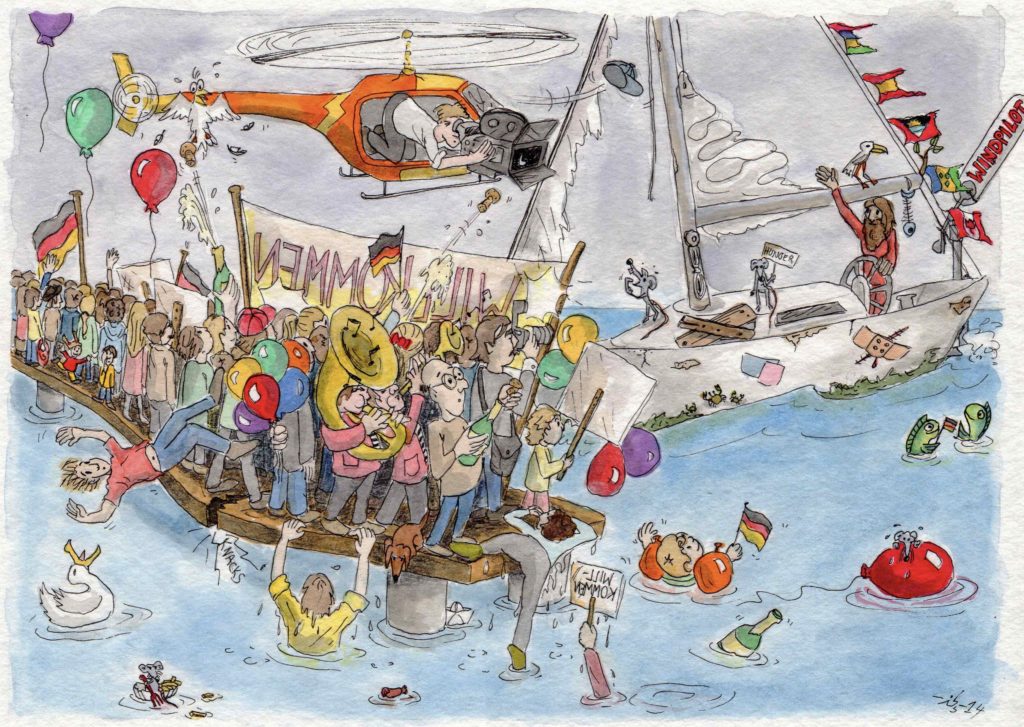
The GGR’s media affairs were handled by yachting journalist Barry Pickthall, one of the leading lights of his trade, who worked up the organiser’s reports and distributed them to media outlets worldwide. These ready-to-use press releases must have been a welcome treat for financially strapped editors – an attractive distraction with the potential for code yellow or even code red sensations perfect for a dramatic headline (Abhilash and Susie certainly obliged). Seductive and dressed up with copious high-res pin-up photos, they were just perfect for today’s cash-strapped, time-poor journalist (in whatever field) on the lookout for an easy copy and paste job. Filling column inches in this way saves time and money, no doubt, but it rather undermines the journalist’s role too: who needs an intermediary if all they do is parrot the content they are sent with no independent research and no trace of a critical eye?
It was this state of affairs that allowed the GGR organiser’s opinions (shaped by his inability to comprehend facts inconvenient to his sponsor) to be promulgated unquestioningly by editors around the world – with unedifying consequences for the event and my own brand.
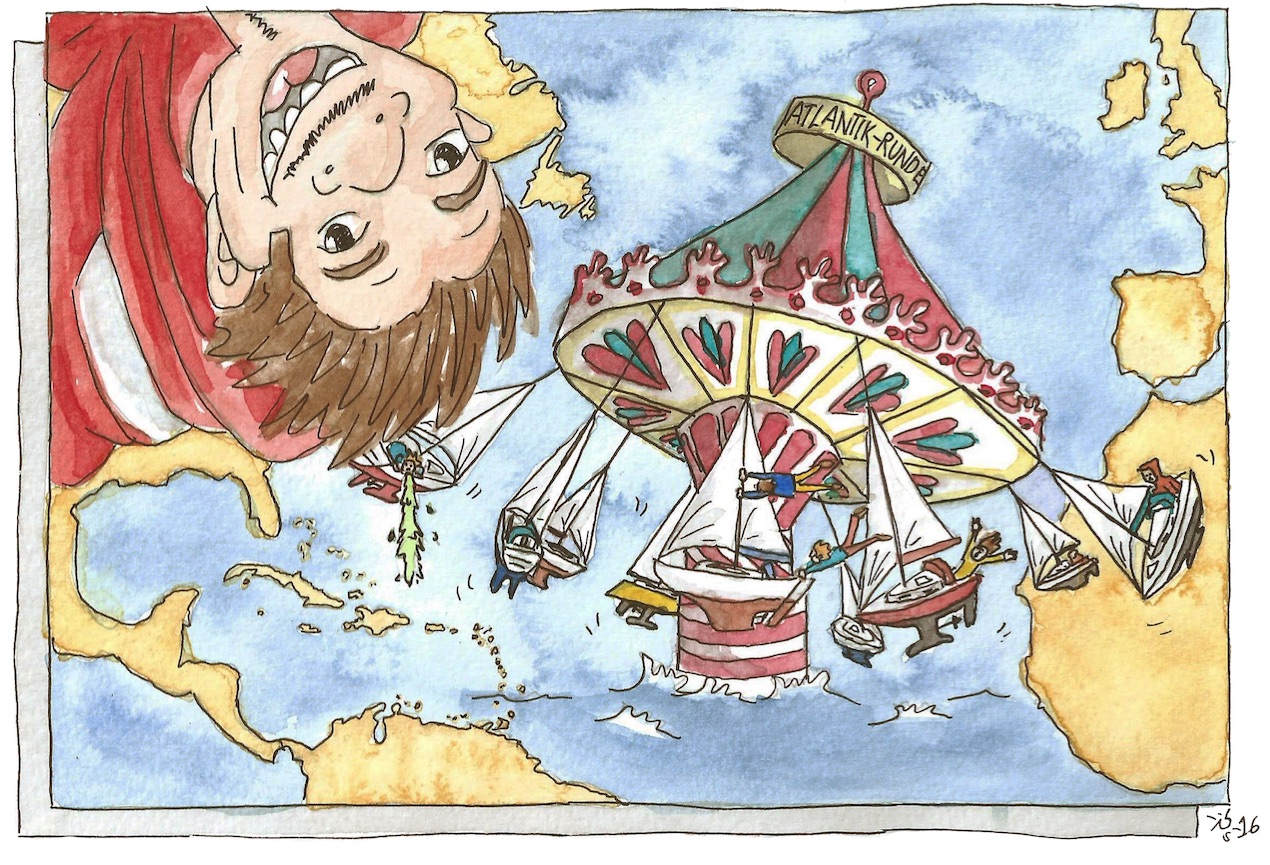
It was the realisation that the media would regurgitate whatever it was fed with no attempt at independent verification or plausibility-checking that led to me publishing my own views here and scrutinizing the podcasts for meaningful information from the horse’s mouth. How does it make any sense that I, an obvious supporter of the event and sponsor of five GGR sailors, should end up having to confront the organiser’s harmful claims about my products head on and in a public forum just to try and set the record straight? It may be unreasonable, unjust and unjustifiable, but mostly it’s plain ridiculous and ended up casting a long shadow over the whole of what should have been a wonderful event.
Impartiality is vital and its absence is difficult to ignore. I will limit my remarks today to the observation that trading blows in the public eye is unproductive and seems highly likely to discourage potential backers, especially given that the competition for media reach turns not on the number hits generated, but rather on content and factual reliability as determined by an audience that knows how to split the wheat from the chaff.
Contacting Barry directly seemed like the logical next step. Surely he, one way or another, could help me track down a competent journalist/author capable of tackling the windvane issues? Surely he could not. Not through any fault of his own, I must add, but because it seems, for the reasons set out below, that it just cannot be done.
CREDIBILITY

The first reason was all too familiar; indeed coincidentally it was the same reason I found myself having to face down a legal challenge in the High Court in London in 1998: credibility! Can I, as a manufacturer, write reports or books on my specialist subject and should I be allowed to? The High Court confirmed that I could. After 45 years in the silent self-steering business, I had to smile when Barry put this question to me over the phone.
The search for a suitable author proved difficult. Barry, for his part, suggested Dick Koopmans and Gerard Dijkstra. Both are best-known for their work as naval architects, but Dick was also team manager for Mark Slats in the last GGR and Gerard wrote a very well-received book on self-steering in the late 1970s. Incidentally, Dick and Gerard have both been Windpilot users for many years.
Negotiations with magazines – print and online alike – and freelancers turned out to be anything but straightforward: I didn’t want to buy advertising space to oil the wheels, I didn’t want anything to do with cost-plus contracts, the apparent lack of expertise available troubled me and there didn’t seem to be much willingness to give what is a very important topic for offshore and bluewater sailors the editorial priority I believe it deserves. I have been down this road before. There’s nothing new about struggling to make journalists understand why something is important for their audience and why they owe it to the public not to let key facts slip through the cracks. It was partly because of this that I decided a good 20 years ago to turn my back on advertising and trade fair purgatory and put my faith instead in worldwide direct marketing and the strength of word of mouth. Yes, the solution was staring me in the face: if there was going to be a windvane report, I would have to write it myself.
I understand what Barry meant when he suggested a windvane report from my desk might be considered to lack credibility, but it was ironic to hear it from the man tasked with for bringing news from the GGR to the world! Obviously my impartiality may be questioned, but I set down my doctoral thesis with meticulous care nevertheless. I consider the Windvane Report the most important contribution to my blog because it effectively distils 45 years of experience with transom ornaments and has become far and away the most-read article on my site (which has been operating for nine years).
All that remains for now is to spell out once again what I have already announced in correspondence with various prospective competitors for the GGR 2022: I do not intend to have any involvement with this event in future. I am accustomed to treating sailors with respect and enjoying their respect in exchange. The GGR brought me into contact with people who play by different rules.
That’s not the way my world works.
Hamburg, 07/09/2019
Peter Foerthmann


































That’s an interesting read Peter, now tell us who the artist is that illustrated the article?
Thanks
Hi Drew,
SV Olgalou is owned by Inga and Vassil, German – Bulgarian liveaboard couple, their Nicholson 31 currently in Papeete ( for sale) whilst after 10 years of travelling the owners returned back to Europe … both longtherm Windpilot sailors … after getting some very nice cartoons at X-Mas I have discovered some years ago to suggest kind of joint cooperation as Inga is a professional cartoonist. This blog is crowded with her beautiful artwork since and all the three of us enjoy the benefit out of it as Vassil published some short stories about liveaboards experiences during years. The story is linked here, some language training for an Australian skipper living far away from Germany … but Google translate might help.
https://windpilot.com/blog/morphy-blitz/vassilingalou/
Hi Peter
Your GGR article was an eye opener for me.
As a SAR helicopter pilot for much of my career. Involving many operations driven by extreme weather events, I have had a birds eye view of survival conditions that made me re-consider my own cruising plans more than once. And it outlines how little many cruising sailors (such as myself) have to learn, even after decades of cruising. (1.5 RTW & 3 Atlantics since 1973)
As my boat sizes grew with relative prosperity, my WSS grew with it, running through Navik, Aries, Fleming, Monitor.
Then as my boat sizes decreased again (age), I ran back down the available range until the latest Pacific light 3-4 years ago.
I bought all my previous WSS gear second hand. In fact the unit I bought from you was actually the first brand new WSS I ever owned and I’ve loved it from day one. It’s lack of seasickness, uncomplaining ability to just keep going when times got tough.
Just it’s simple reliability. I have watched it for hours on end waiting for something to fail…
I’m still waiting!
Against all common sense in today’s world of overpriced marinas and my own advancing years.
I’m upsizing again and will need a larger Windpilot ….the choice is clear!
Paul Johnson.
En-route Dakar to France
Air France 719
Going to windward at mach 0.85 😉
Hi Peter,
sorry to hear about that I do believe the wind pilot is one of the best out there but I understand your decision, I will still be using my wind pilot for a few yrs still before I change it when I do the full refit
All the best for the future.
John Clark, SY Skyblue
entrant GGR 2022
Dear Peter,
Thx to your unpleasant experiences with the GGR everyone is able to get intense information about what is what. Stripped down to the bare metal. I salut and thank you for that.
I cannot imagine the next GGR without Windpilot. Time will tell who will be bold enough to go without a windpilot anyway.
Sure as hell I would.
Cheers.
Eli van den Broek
Peter,
To carry a spare rudder should be normal practice for GGR. I guess that most of round-the-world races require spare rudders to be carried and which are quick to install. But I would keep this separate from windvane steering equipment.
If you steer by a windvane/small rudder system, there still should be, in addition, a spare rudder which is easy and quick to install. Just as you say.
not to forget to mention: I carry a spare rudder onboard Bestevaer2, it is small, but will bring the boat home
Cheers,
Gerard
Hello Peter!
I just finished reading your blog. I think your Windpilots speak for themselves. I am a huge fan and there is no doubt about it.
I had a message from Gaurav that you would not supply one to him. I was taken a bit aback. I hope you did not mean that you won’t sell him one. Or was it that you won’t sponsor him one.
Anyway. If I were to return to the race I am going to take a windpilot with me.
No doubt.
My crew agrees.
Warm regards from Ved, Abhraneil, Urmi and I to Marzena and to you.
Abhilash
Hi Peter,
having been involved in some of your windvane report, nothing is really news to me in this posting. But of course it elicited some new thoughts.
One, I think the first interested to guarantee a perfectly functioning self steering system on an event of this magnitude is the sailor himself. This kind of paternalistic rule should have no place in such an event, like dictating which windvane models are approved. First, approved by whom, based on which data. The spare rudder or emergency rudder rule is understandable, but I agree with Gerard Dijkstra when he says it should have nothing to do with the self steering. Of course if you can make both work together, better, but spare should mean, put aside, not under risk from the every day grind of the voyage itself. If your main rudder “has left the building” as you say, you want a fresh out of the locker device to take its place.
Hence your SOS rudder or similar designs have their place, and the way we integrated both the spare rudder and a Pacific for self steering this spare rudder, seems the logical way to go to me. I admit partiality on this point.
Two, in my 23 year cruising life, I have never thought that I could do it all with just an windane unit. Any realistic sailor knows that there will be moments when a reliable autopilot can make the difference between successfully managing a situation, or ensuring some rest, or being prone to mistakes or accidents due to overriding situations or fatigue. Of course, if you don´t have it you don´t have it, but if you can, why not. So I always used a reliable wind vane self steering system, but whenever I had the means, I also had an inboard hydraulic autopilot to do the back up and for motoring situations.
I once heard an interesting phrase: Captain Cook took all the best technology that was available to him at the time, and so did all other great explorers and navigators, even the Polynesians. So taking the best you can have does not make you a failure.
And as you commented, the human and psychological challenge in this race is already a big enough summit to climb, and having a GPS or a radio modem for grib files does not really make it all that much easier. Anyway, unless the competitors were using specially made or arranged satellite phones and AIS transponders ( I am not saying they were not, I have no information about this to affirm anything ), most of these units have a GPS position on them, which mostly can be accessed by the user.
Lastly, I must say I agree with Abilash, you may not sponsor, but surely you are going to sell units for competitors who want them, aren´t you? I would say this is in their interest. I for myself would not go anywhere near a long passage under sail without my Pacific. No pacific, no race for me, sure.
Congrats on all your excellent work!
best from Lisboa
Luis Manuel Pinho
SY Teresa
TOTAL WITHDRAWAL FROM GGR PARTICIPATION
I should comment the suggestion of Abhilash, Eli and Luis.
The thought of selling my systems for the next GGR is an attractive one of course but I still remember too well my unspeakable experience in the last race: seeing the organiser damage my brand in LSO even before the race had started, seeing him gladly offer assistance to sailors and their shore team during the race when it seemed likely they might switch to a different windvane system and seeing him refuse to engage with my advice or pass it on to sailors who needed it.
I think the organiser lost his credibility when he demonstrated his willingness to give up any semblance of impartiality in order to promote his sponsor ??? and credibility is everything in this situation. Don said, “let’s all have fun in the GGR” but the reality for me was anything but fun and I really don’t need to go through it again.
Peter
As Abhilash has mentioned I reached out to Peter for a quote for a Windpilot system for my Baba 35. I DID NOT ask Peter to supply one as sponsorship, my entry is going to be a Corinthian entry. Peter humbly refused and pointed me towards his blogs which I had already read. I agree with his reasons, but disagree with his decision.
My decision with Windpilot was based solely on the experience of Abhilash and also because I was planning to change my Baba to a tiller steering system due to the reliability of the windvane interface.
Though I am disappointed in Peter’s refusal to get involved with any GGR sailor, I understand his reasons and that decision is solely his.
There are risks in every event and every afternoon sail, as a matter of fact there is also a risk to life as you sleep in your cozy bed. Some of us competitors in the 2022 race have taken the decision to participate because we find benefit in this event that we feel outweighs the risks that it poses. Our decision to participate is solely ours and that of our families. Honestly, no one would give a rats ass if one of us circumnavigated alone- this event, positive or negative- gives us an opportunity to put ourselves out there in this world of commercial interests that might benefit us in the future. We all have to care about our interests, however romanticized our comments on this race in the media are. GGR is as much about fame and publicity as it is about fulfilling our dreams. Anyone denying that is lying, otherwise we would be out at sea right now and not waiting for 4 September 2022. Vendee Globe had its problems, they got fixed, I am sure GGR will fix them too, in numbers they are already ahead of the first GGR.
That said, I am disappointed by Peter’s decision as it denies some of us the opportunity to sail with equipment that has proven its worth. As Abhilash said, his WSS survived the dismasting and 40% of the finishers of the 2018 race used Windpilot. I urge Peter to revisit his decision. Perhaps put in a plan or agreement with competitors to make sure proper installation and usage of the system. If the sailor does not comply, he could very well take back his wind-vane and walkaway from the sailor itself. His blog does outline that the biggest problem for him was that he never got sailing time with Istvan and Antoine and could not rectify their installation issues.
Peter, the decision to supply your windpilot system is yours and I respect it. If you do change your mind, we have three years before the start and get a winning team together.
Gaurav
GGR 2022 entrant
Thank you for yet another interesting blog.
You have got me thinking, and researching in particular high latitude use of wind vanes vs electronic pilots. It seems Vito Dumas did okay without either wind vane or electronic pilot.
Mike Smith, SV Pingo
GGR 2022 entrant
Dear GGR 2022 entrants,
I am convinced that you should not place your message to Peter, but to the organizer and especially to Don!
That Peter doesn’t want to expose himself to another theatre like 2018/19 is really comprehensible.
And if a fair competition for the „best solution“ does not contribute to the safety of sailors, then it is a lousy position. The organiser of the GGR is responsible for this.
Hallo Peter,
Wir waren sicherlich nicht das einzige Boot welches mit einer Pacific Plus Kap Hoorn umsegelt hat. Nach einer 5jährigen Weltumseglung und weiteren 4 Jahren habe ich in diesem Sommer bei Dir das erste Ersatzteil geordert und sofort erhalten.
Nochmals vielen Dank und alles Gute
Hans
SY RESOLUTE
Peter, your decision not to sell Windpilot units to participants in GGR 2022 is understandable and one must respect it. However, I wonder if your decision will protect your company from adverse publicity. People may not read this blog, and then they will just see that there are no Windpilots in GGR 2022, and it seems to me likely that they will draw the conclusion that competitors chose not to install them, that they have come to the conclusion that your equipment is not good enough. And that is far from the truth, as testimonials from Tapio and Abhilash, and the race results, prove. I think that if the public sees that competitors choose Windpilot again for this race, knowing the results of GGR 2018, then that is a powerful endorsement that is independent of bias.
Hi Graham,
life still is a compromise. From now 44 years of living in a market niche of transom ornamentation I am rather trusting on Word Of Mouth of the cruising community, the more as I am convinced that any sailor interested about a silent steering slave will find the way towards information. The wind vane report raises facts which are self explanatory.
best Peter
Dear Peter
Windpilot Pacific, in my opinion, is the best Windvane equipment on this earth. Quite simply because it has been significantly evolved since the 1980s. The others have not. Weaknesses have been addressed, performance has been improved, longevity has been increased. All done by perhaps the most highly skilled expert in the subject alive today. And all without a significant increase in price!
It can be fun to romantically reminisce about old things, like this 1970s Robin Reliant:
https://classicsworld.co.uk/wp-content/uploads/2018/03/RELIANT-ROBIN-MKI-820×547.jpg
But it comes to something which we use every day, which must be reliable for our safety and sanity, i prefer a VW Golf.
For the GGR organiser to wed himself to the clearly dated and surpassed solution from his financial sponsor, showing clear bias and putting further strain on his entrants, is hard to comprehend.
Your decision to not supply Windpilot equipment under these circumstances is only logical and the correct conclusion. Sailors world wide, who care about self steering, know that Windpilot is the best. It only takes 1hr on the net to work that out.
Much continued success to you!
Kind Regards
Oliver Schörnock
I have searched through all the GGR official information online, especially it’s videos. I cannot find the video in which the approved windvane-as-spare-rudder was tested around the specified triangle in the specified conditions.